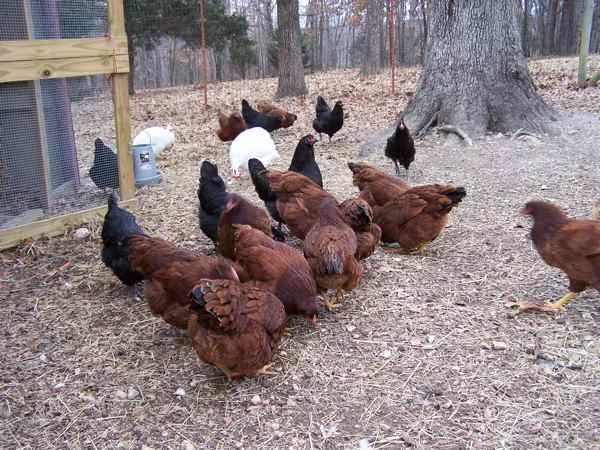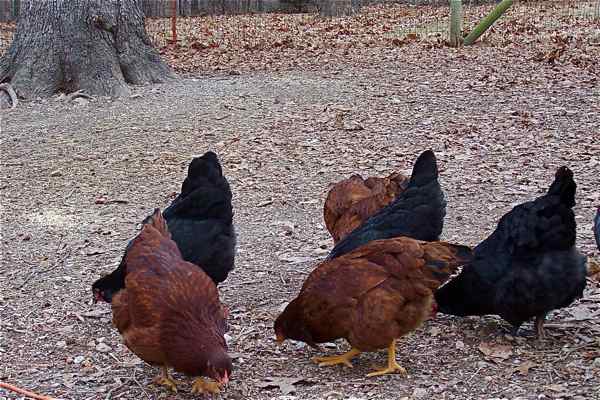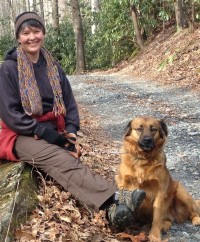Last Days of Winter Snapshots…
It’s nearly, but not quite, Spring. The plum tree has jumped the gun a bit and is demonstrating why plums are prone to being hit by late frosts around here in the Ozarks. But isn’t she lovely in the meantime and the bees are not complaining about it either. On a lucky year without a late frost, we could be blessed with plums. We still have a bunch in the freezer from last year, one of the lucky ones, from a friend’s tree.
I’ve been so busy the past months, getting ready for the Dig In! Food & Farming Festival which happened the first weekend in March. It was a great time and a wonderful crowd! That festival is something I’m so pleased to have co-created. I hope it will go on and grow abundantly in future years, even though I’ll likely be back on the homeward side of the country by then. Our planned move back home to the Appalachians is creeping closer. It’s hard to imagine leaving the birthplace of Larrapin Garden, but we hope to find new owners who will love it and cultivate it as we have. If you know of anyone who might be looking for a place like this later this Spring, please send them this link: http://minifarm4sale.wordpress.com/
Looking around I seem to see good memories that pull at my heart from every corner of the garden and woods. Writer Stephen Levine calls this ‘the consequences of love.’ Indeed. Right beside that sadness about leaving is the excitement of a new adventure and a new landscape to fall in love with the way I have this one.
I invite you to join me over at the brand new Facebook page , on Pinterest, or on Twitter…however you happen to roll in cyberspace. Leigh
Read MorePutting the Bees to Bed
The weather report said it would be the last sunny, wind-free day in the mid sixties for at least a couple of weeks. As we headed into December, actual winter or at least what passes for it these days, was about to begin. One beehive still needed to be sized down a bit, consolidated into fewer boxes so the colony would be better able to keep the space warm through whatever cold nights and windy days we might have. I’d arranged the other hives a month ago, but West hive had been crazily overflowing with bees. I couldn’t imagine making their quarters any tighter, so I’d waited till they thinned out a bit for the season.
Bees “cluster” in the winter, form a pulsing ball of thousands of bees with the queen safely sheltered in the center. The bees vibrate their bodies to create heat. As the outermost layer of bees tire and get cold, they rotate toward the center, and their warmed-up sisters take their turn in the outermost layer. Fueled by the store of honey they worked all summer to stash, this process goes on constantly anytime temps in the hive fall much below 50F. At the center of that pulsing cluster, the queen basks in cozy 95 degree bee-generated warmth.
I put plenty of wood chips in the smoker because in the fall and winter the bees are at their most defensive. That honey stash is life or death for the whole colony and they are hellbent on protecting it even if the beekeeper is not interested in taking any honey. You can’t be too careful, the bees would say. I suited up more carefully than usual, put on the thicker dishwashing gloves rather than the thin ‘nurse’ gloves I usually use. Doublechecked my jeans tucked into my boots for bee-sized openings.
In Spring and Summer the typical lifespan of a honeybee is six weeks. But the winter bees are born for a special job and live for months in a near-nonstop vibrating process of working to keep the colony alive. You can put your ear to the hive in winter to hear and feel a low steady vibration. Over the winter these determined workers die off steadily but with full honors. On warmer days the workers muscle up funeral duty and haul the fallen to the doorstep and..toss them off. Honor sure, but duty to keep the hive clean comes first.
I began to take apart the top boxes of the hive. The most difficult part was pulling out frames of empty comb and combining frames with honey into fewer boxes. The bees glue the whole hive together with propolis, a tarry glue they make that is the honeybee equivalent of duct tape. Propolis is also sold as an antimicrobial medicinal at health-food stores. The bees use it to make their home strong, windproof and highly unlikely to come apart. In summer it’s gooey and sticky and just makes a mess. In the cooler temps, it is as hard and strong as caulk and every frame had to be pried loose with great effort. All while trying not to make the jarring, banging or jerking movements that piss bees off and sometimes crush bees which REALLY pisses off the bees. I didn’t venture into the lower boxes where most of the bees were gathered, for obvious reasons. (Photos below courtesy of my friend Marianne, from back in May.)
Winter is a critical time for a colony of honeybees. Survival depends on many only-ifs. The colony will make it through winter only if there are enough bees to create a cluster large enough to both maintain heat all winter and to have enough workers remaining to nurse their replacements to adulthood in the Spring. That’s only if the queen survives to lay the eggs to create those replacement troops. And only if they have enough food to fuel this 24/7 process. The colony is also at highter risk for the some diseases brought on by close quarters, and other illnesses brought on by the parasitic mites that have been one major factor in the decline of honeybee populations.
As I worked through the upper boxes of the hive I saw West Hive didn’t have as much honey stored as I’d hoped, but being a first year hive coming out of a drought year, that’s not too surprising. Most new hives will require supplemental feeding at first. I’ll use thick sugar-water mixed with nutritional oils to try to get them through till Spring. Sugar is better than the corn syrup used by some beekeepers but still not nearly as good as honey. Even if I could afford to buy honey to feed this colony, the risk of transmitting diseases from another bee yard would not be worth it. Hopefully as I have more hives, I can store extra frames of real honey from established hives to gift to new hives their first winter.
West Hive was gentle with me after all. They allowed me to get the boxes ready for winter while only giving me a loud buzzy warning to do it fast and don’t mess with the lower boxes. I agree. Putting the bees to bed for winter feels both warm and worrisome. I’ll keep an eye on them during mild winter days to see if they are venturing out and make sure they still have enough food. I’m cheering them to stay tough and make it through till Springtime brings the flowers and sunshine back. Till then, stay warm and safe, sweet sisters.
Read More
Garden Spider Signage
We’ve had more garden spiders this year than ever. They are so beautiful in a predator kind of way. I do appreciate how they put signage up for the birds — that zigzag weave down the middle — so the birds won’t run into their webs. While I know this isn’t just kindly thoughtfulness but rather it must be a lot of trouble to rebuild a bird-smashed web. Still, it seems like a nice deal between the spiders and the birds. It also helps the gardener not run into the web one large spider like this one has built all the way across the path between the tomato beds. The gardeners, like the birds, take the detour.
Thanks for stopping by Larrapin Garden, where praying for rain accompanies breakfast, lunch and dinner too.
Read More
Buckeye Pullets at 5 months [Flashback Post]
Was just thinking today of starting a new batch of wonderful Buckeye chickens. I’ve been so busy with other projects, my girls have gotten quite “mature” in chicken years…though they are still busy eating garden weeds and any bug they can catch, shredding compost and laying the occasional egg. Haven’t heard of the wonderful Buckeye? Buckeyes are a heritage breed that would have probably been lost if not for the efforts of the wonderful American Livestock Breeds Conservancy. Here’s what their website says about Buckeyes:
Buckeye Chicken
The Buckeye is a dual-purpose breed of chicken with a deep, lustrous red color of plumage. They have yellow legs and skin, and, thanks to their pea comb, are very cold-weather hardy. While Buckeyes adapt readily to a variety of living conditions, they do best under free-range conditions, or conditions where they have room to move around. Because of their active nature they do not do especially well in small confined spaces. Roosters weigh approximately nine pounds; hens weigh approximately six and a half pounds and lay medium-sized, brown eggs. Buckeyes were developed by Mrs. Nettie Metcalf of Warren, Ohio, and appropriately named after the “Buckeye State.” Buckeyes are unique in the American Class of chickens in that it is the only breed created entirely by a woman.
Now that’s pretty cool! They also have made it into Slow Food’s Ark of Taste for their rich meat.
So please enjoy this flashback post from 2009, when the girls were just five months old:
Buckeye Pullets at 5 months—Winter 2009
Is that a handsome gal or what? The Buckeye pullets are 5 months old now and beginning to look like real grown-up hens. (You can find out more about Buckeyes by clicking here to go to the American Livestock Breeds Conservancy page on the breed.) I’ve raised this batch of Buckeyes and Australorps from day-old chicks. We only had one chick lost out of two-dozen, and that was on New Year’s Eve to a huge owl who went inside the open door of the chicken shed at dusk and got an Australorp…
Here are the girls at scratch-time – their favorite time of the day!
The Buckeyes are almost as big as the Australorps, but the Australorps are heavier. I still love those big yellow feet on the Buckeyes.
So once I tossed out the scratch, I couldn’t get them to pay me and the camera any more attention.
Thanks for stopping by Larrapin Garden!
Read MoreFirst Honey at Larrapin
There are some crops that make you wait a long time. I’m thinking asparagus, fruit trees, and honey. I got the first beehive over a year ago. Sometimes you get honey from a first year hive, but everything has to go perfectly. That first year, things did not. The first batch of bees (a “package” of bees and a queen) absconded. That’s beekeeper talk for they all hit the high-road and didn’t look back despite the lovely home I’d provided. The beekeepers said, “They do that sometimes.”
Then I was given a wild swarm and they settled in and began happy bee homemaking. I also bought a nuc (several frames-full of bees and their comb and their queen) from a conventional beekeeper in the area. They were troublesome and had continuing problems. The beekeepers said, “They do that sometimes. It can be difficult to transition them to organic.”
Most folks have no idea the boatloads of chemicals used on bees by conventional growers. Once you know, you will never buy storebought honey again…. even if you hadn’t already heard that most of the commerical honey, when tested, contains corn syrup as well as chemicals forbidden even by the lax US standards. (China & India ship honey to other countries to then sneak it into the US market which bars it due to the chemical and antibiotic load..) Don’t get me started…
The short answer is: buy local, naturally-grown honey from a beekeeper you trust. You want one who only uses at most “soft treatments” to control the many ills—mites in particular—honeybees are prone to in this modern world. Natural beekeepers are glad to tell you how they manage their bees. (In Northwest Arkansas, I can highly recommend Crosses Creek Farm, where the beekeeper is my mentor’s mentor and is he is all about natural beekeeping. We were very lucky to get him to bring his honey to the new Green Fork Farmers Market.)
Anyway! The wild swarm who was by then named “East” was still doing great and the nuc named “West” was at least holding its own last year when the heat dome hit. Temps above a hundred and no rain for more than a month will dry up every source of nectar and make the bees really, really grumpy besides. East Hive weathered it, so to speak, but the nuc was toast, though they held on till early winter, may they rest in peace…The beekeepers said, “They do that sometimes. Sorry”
This year has been totally, utterly different. The winter was mild. Ok, it was so mild it barely counts. Spring came early and stayed. Everything bloomed crazy early and just kept blooming. Bee nirvana. East Hive crammed their hive with honey so fast I had to stack more and more supers on top to try to keep up. The beekeepers said, “They do that sometimes! Isn’t it great!”
They were SO prosperous they threw a swarm (that’s the bee version of the birds & the bees – hive reproduction) which was lovely to see except that I couldn’t get to it in the tip top of a tree, and so alas for the beekeeper, but happy for the world that another colony of bees ventured into the forest not so far from where the original swarm was found. You guessed it: They do that sometimes.
There were still loads of bees left in the hive though, lucky for me. While that seems fair this time—to return one swarm since I took one swarm— but next spring I will try yet more tricks to keep the swarms at home! Let me emphasize that beekeeping is THE most challenging hobby (ok, obsession) I’ve ever chosen. In hindsight, I’m not sure who chose whom! But I’m hooked, and this spring added two new hives—West II and the SugarBs— plus did a split (split off a “baby” hive from East, which was supposed to keep them from swarming but didn’t! Named the baby hive “Rose” because so many roses were blooming at time.) So now there are four.
Even I won’t get as much honey as I would have if East-Hive hadn’t swarmed, there’s still plenty to get. I suspect I can do a full spring harvest from East next week. This week, I just took one small frame as a sampler and got this lovely jar pictured at top. I had just poured it—those are air bubbles in the honey. It has since settled into the loveliest amber and is light and delicious beyond description. Partly because it’s the nectar of our own land and bees. Or perhaps because we are their humans and ruled by the whims of four ruling queens. Either way, it’s golden.
Read More










![Buckeye Pullets at 5 months [Flashback Post]](https://fiveapple.farm/wp-content/uploads/2012/06/buckeye-pullets-186x186.jpg)






